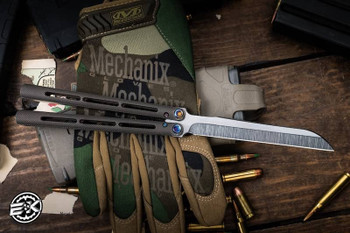The Basics of Balisong Knives
Posted by EKnives on Jan 23rd 2025
You've been hearing the inescapable siren song of a new balisong and are eager to start shopping. We don't blame you; these are pretty awesome knives. Suitable for everything from cutting lines to cleaning fish and self-defense to shaving (yes, really!), you can even use these knives for entertainment. Forget the fidget spinner; flipping your balisong is really flippin' fun. (With safety always in mind, of course.)
Balisongs are part utility tools, part cultural icons, and part entertainment. Finding the right balisong can elevate your tool kit, advance your EDC game, and enhance your blade collection. If you are new to these fun knives, you should know a few things when considering various balisong knives for sale. Here's our essential guide to these knives:
What is a Balisong?
Let's start with the basics: what is a balisong? Also known as a butterfly knife, a balisong is a folding pocket knife with two handles. These handles rotate around the knife's tang.
No, we aren't talking about the juice astronauts drink. A knife tang is the part of the blade metal that extends into the handle. It secures the handle to the blade. With a regular kitchen knife, the tang is fixed inside the handle. With folding knives, the tang is the part of the metal that extends just far enough beyond the blade to create a hole for the pivot point. For a typical folding knife, the blade folds down to settle inside the knife, using one rotating point.
On a balisong, there are two handle pieces. That means that where a traditional folding knife has two parts (blade and handle) a balisong has three (a blade and two sections of handle that rotate in opposite directions). When the handle pieces are open they sit next to each other, operating like one handle. When you close the knife, you separate the handle sections. The pieces counterrotate, coming together again with the blade concealed inside them.
The word "balisong" comes from the Barangay Village in the Philippines, where these knives were first popular. They are also called butterfly knives or fan knives due to the motion of the two sections of the handle. These knives are sometimes used for tricks or entertainment. They create a constant, rhythmic clicking sound as they are repeatedly opened and closed. This sound led to another nickname: click clacks. Finally, you might hear balisongs called Batangas knives.
Another important note about this type of tool is that this type of folding knife is restricted in some countries. Some states in the USA have restrictions on their carry or possession. Be mindful of local rules before purchasing or carrying a balisong knife. If local laws restrict balisongs in your area, other folding knives or EDC knives might offer similar utility with fewer restrictions.
Anatomy of a Balisong
Let’s take a look at all the parts of a balisong knife.
Bite Handle
The bite handle is the handle piece that closes onto the sharp edge of a balisong's blade. If you are holding this side of the handle when you close your blade, it is easy to cut yourself. The knife's latch is usually on the bite handle side.
Choil
The choil is the blade's unsharpened part. This part of the tang, found just above the kicker, makes sharpening easier.
Kicker
Also known as the kick, the kicker is a blade section between the sharpened edge and the pivot pins. It prevents the sharpened edge from scraping the groove inside the handle, which could cause damage.
Latch
The latch is your knife's locking system. When closed, the latch keeps your balisong closed. The latch is usually on the bite-handle side of the knife.
Latch Gate
A latch gate is a block inside the channel of the handles that stops the latch from impacting the blade.
Pivot Joint
A pivot joint is the point around which the knife's moving pieces rotate.
Safe Handle
The safe handle is the one that closes over the blade's unsharpened side. One side is the bite handle, and the other is the safe handle.
Tang
The tang is the blade's base. It is where pivot pins attach the handles.
Tang Pin
When balisongs are closed, tang pins hold the blade away from the handle. Some balisongs have a second pin on the tang. This pin keeps the handles from impacting against each other when the knife is flipped open and closed.
Trainer
We are cheating a little since a trainer isn't really part of a balisong's anatomy. We still thought it was worth including on our list since it's a term you will see when buying butterfly knives. A trainer balisong has an unsharpened training blade. It mimics the motion of a balisong with a live blade, allowing you to practice the knife's fun flipping motion safely.
When possible, get a trainer designed specifically for the live-blade balisong you intend to purchase. That means the weight and balance of the trainer will be similar to the live knife. For example, if you find a Benchmade balisong for sale, a companion trainer is likely available. If both are the 99 models, the feel and motion of the live and trainer versions will be nearly identical.
A balisong is more than just an unusual, eye-catching knife. It's a versatile, reliable tool. Whether you want to make this your EDC, seek something fun in your collection, or are hoping to gift a great knife, a balisong can leave you with a song in your heart and a smile on your face.
Infographic
Balisongs serve as practical tools, cultural icons, and entertainment. Selecting the right balisong can enhance your toolkit and everyday carry (EDC) setup. If you're new to these knives, learn about their parts in this informative infographic.


